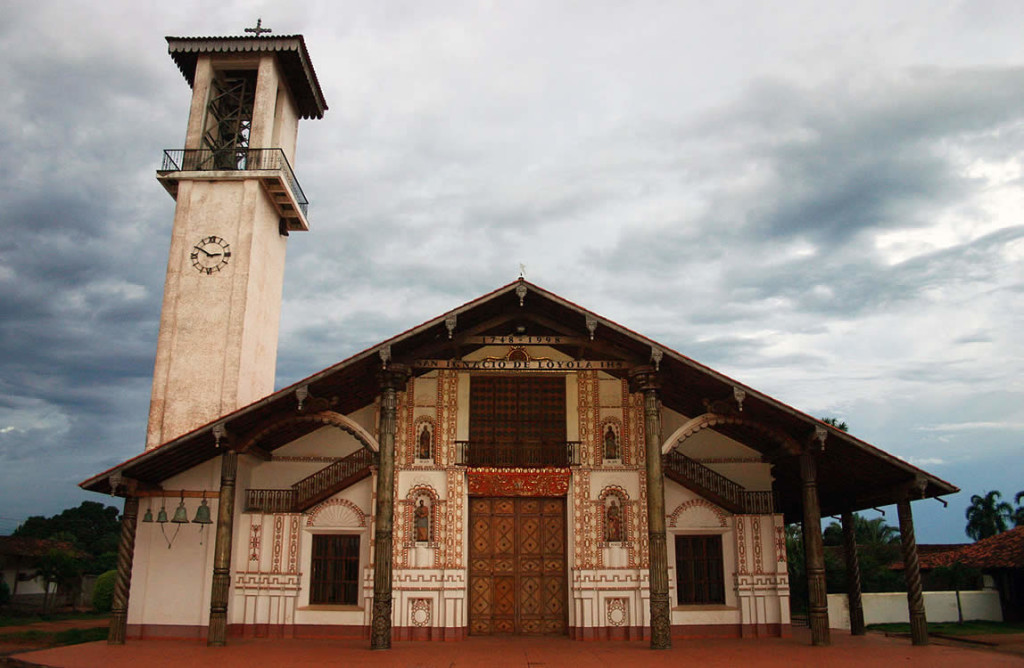Written by Geoffrey A. P. Groesbeck
San Ignacio de Velasco was founded in 1748, primarily for the benefit of the local Ugaraño peoples, by Jesuits Miguel Areijer and Diego Contreras. It was settled in part by the inhabitants of a former reducción, San Ignacio de Zamucos, which was destroyed three years earlier. One of the few missions that was not eventually relocated, San Ignacio, along with Concepción and San José de Chiquitos, has always been regarded as one of the three principal Jesuit settlements. Today it is the largest town on the Jesuit Missions Circuit, with a population of some 50,000 inhabitants.
Situated between Concepción to the west and and San José de Chiquitos to the south, it is a major transportation hub in the Chiquitania. As such, it is served by most regional and national bus lines, and boasts a small airport. Its location makes it an ideal spot for exploring the neighbouring mission settlements of San Miguel de Velasco, San Rafael de Velasco, and Santa Ana de Velasco, which are no more than an hour’s drive away. The last settlement of any size heading east before San Matías on the Brazilian border, in addition to being the capital of Velasco Province, San Ignacio also serves as the primary southern gateway to the incredible Parque Nacional Noel Kempff Mercado to the far north.
San Ignacio is usually the third Chiquitos mission settlement, about 106 miles (171 kms) east along a recently paved road from Concepción.
Its culture is closer to that of Brazil’s than most of Bolivia’s, and the people are some of the friendliest anywhere. Hand-carved wooden crosses flank intersections as one approaches the main plaza, and in the distance is a beautiful lake, Laguna Guapomó. It offers boating, swimming, and fishing. Yet the town, for all of its agribusiness interests and rare game hunting, still has a quaint, colonial feel about it.
There’s plenty to see and do in San Ignacio, even after taking in the magnificent cathedral. The building is a reconstruction of the Martin Schmid-designed original destroyed by fire in 1808, and also is the only templo on the Jesuit Missions circuit that was not declared a World Heritage Site by UNESCO. (The reason for this is that the church is new, and a reconstruction, although it is largely faithful to the original, and not a restoration of the original. Only the sacristy remains from the first church.
Start with the plaza principal – the tranquil Plaza 31 de Julio. The Casa de la Cultura is here, as is the Museo Misional. Also housed here is the Oficina de Turismo, which can tell you what’s happening around the area.
If you happen to arrive when the local choir and orchestra are practicing, you will hear Baroque- and Renaissance-era religious music being performed.
If you want a nice view of the town and its immediate surroundings, climb the Cerro de la Cruz just outside of town. To the south of the town is El Mirador de La Cruz, which affords wonderful panoramic vistas.
San Juancito
There are also several indigenous settlements (called comunidades indígenas) in the area. San Juancito (12 miles, or 20 kms west of town) and San Rafaelcito de Sutuniquiña (3 miles, or 5 kms, heading towards San Miguel) are the best known.
San Juancito in particular is a great spot for a day or overnight trip, and has a nascent eco-tourism initiative operated by the inhabitants. This is one of the best opportunities in the Chiquitania to see life in a Chiquitano village.
Written by Geoffrey A. P. Groesbeck
